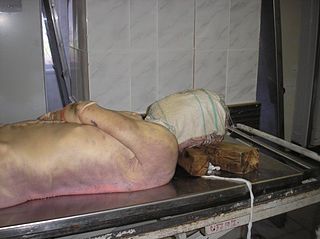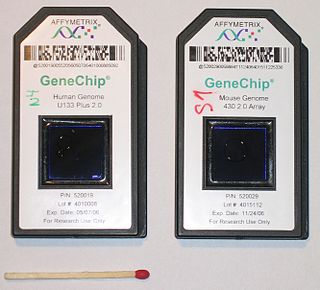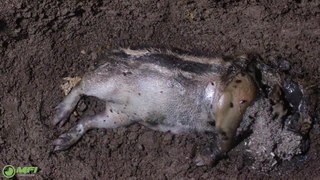
Death is the irreversible cessation of all biological functions that sustain a living organism. The remains of a former organism normally begin to decompose shortly after death. Death eventually and inevitably occurs in all organisms. Some organisms, such as Turritopsis dohrnii, are biologically immortal, however they can still die from means other than aging. Death is generally applied to whole organisms; the equivalent for individual components of an organism, such as cells or tissues, is necrosis. Something that is not considered an organism, such as a virus, can be physically destroyed but is not said to die, as a virus is not considered alive in the first place.

Forensic entomology is a field of forensic science that uses insects found on corpses to help solve criminal cases. This includes the study of insect types commonly associated with cadavers, their respective life cycles, their ecological presences in a given environment, as well as the changes in insect assemblage with the progression of decomposition. Insect succession patterns are identified based on the time a given species of insect spends in a given developmental stage, and how many generations have been produced since the insects introduction to a given food source. Insect development alongside environmental data such as temperature and vapor density, can be used to estimate the time since death, due to the fact that flying insects are attracted to a body immediately after death, determine any possible movement of the body after death, and the determination of antemortem trauma.. The identification of postmortem interval to aid in death investigations is the primary scope of this scientific field. However, forensic entomology is not limited to homicides, it has also been used in cases of neglect and abuse, in toxicology contexts to detect the presence of drugs, and in dry shelf food contamination incidents. Equally, insect assemblages present on a body, can be used to approximate a given location, as certain insects may be unique to certain areas. Therefore, forensic entomology can be divided into three subfields: urban, stored-product and medico-legal/medico-criminal entomology.
Rigor mortis, or postmortem rigidity, is the fourth stage of death. It is one of the recognizable signs of death, characterized by stiffening of the limbs of the corpse caused by chemical changes in the muscles postmortem. In humans, rigor mortis can occur as soon as four hours after death. Contrary to folklore and common belief, rigor mortis is not permanent and begins to pass within hours of onset. Typically, it lasts no longer than eight hours at "room temperature".

Livor mortis, postmortem lividity, hypostasis or suggillation, is the second stage of death and one of the signs of death. It is a settling of the blood in the lower, or dependent, portion of the body postmortem, causing a purplish red discoloration of the skin. When the heart stops functioning and is no longer agitating the blood, heavy red blood cells sink through the serum by action of gravity. The blood travels faster in warmer conditions and slower in colder conditions.

Decomposition or rot is the process by which dead organic substances are broken down into simpler organic or inorganic matter such as carbon dioxide, water, simple sugars and mineral salts. The process is a part of the nutrient cycle and is essential for recycling the finite matter that occupies physical space in the biosphere. Bodies of living organisms begin to decompose shortly after death. Animals, such as earthworms, also help decompose the organic materials. Organisms that do this are known as decomposers or detritivores. Although no two organisms decompose in the same way, they all undergo the same sequential stages of decomposition. The science which studies decomposition is generally referred to as taphonomy from the Greek word taphos, meaning tomb. Decomposition can also be a gradual process for organisms that have extended periods of dormancy.
Putrefaction is the fifth stage of death, following pallor mortis, livor mortis, algor mortis, and rigor mortis. This process references the breaking down of a body of an animal post-mortem. In broad terms, it can be viewed as the decomposition of proteins, and the eventual breakdown of the cohesiveness between tissues, and the liquefaction of most organs. This is caused by the decomposition of organic matter by bacterial or fungal digestion, which causes the release of gases that infiltrate the body's tissues, and leads to the deterioration of the tissues and organs. The approximate time it takes putrefaction to occur is dependent on various factors. Internal factors that affect the rate of putrefaction include the age at which death has occurred, the overall structure and condition of the body, the cause of death, and external injuries arising before or after death. External factors include environmental temperature, moisture and air exposure, clothing, burial factors, and light exposure. Body farms are facilities that study the way various factors affect the putrefaction process.
Algor mortis, the third stage of death, is the change in body temperature post mortem, until the ambient temperature is matched. This is generally a steady decline, although if the ambient temperature is above the body temperature, the change in temperature will be positive, as the (relatively) cooler body acclimates to the warmer environment. External factors can have a significant influence.

Forensic anthropology is the application of the anatomical science of anthropology and its various subfields, including forensic archaeology and forensic taphonomy, in a legal setting. A forensic anthropologist can assist in the identification of deceased individuals whose remains are decomposed, burned, mutilated or otherwise unrecognizable, as might happen in a plane crash. Forensic anthropologists are also instrumental in the investigation and documentation of genocide and mass graves. Along with forensic pathologists, forensic dentists, and homicide investigators, forensic anthropologists commonly testify in court as expert witnesses. Using physical markers present on a skeleton, a forensic anthropologist can potentially determine a person's age, sex, stature, and race. In addition to identifying physical characteristics of the individual, forensic anthropologists can use skeletal abnormalities to potentially determine cause of death, past trauma such as broken bones or medical procedures, as well as diseases such as bone cancer.
Dead on arrival (DOA), also dead in the field, brought in dead (BID), or dead right there (DRT) are terms which indicate that a patient was found to be already clinically dead upon the arrival of professional medical assistance, often in the form of first responders such as emergency medical technicians, paramedics, firefighters, or police.
Coffin birth, also known as postmortem fetal extrusion, is the expulsion of a nonviable fetus through the vaginal opening of the decomposing body of a deceased pregnant woman due to increasing pressure from intra-abdominal gases. This kind of postmortem delivery occurs very rarely during the decomposition of a body. The practice of chemical preservation, whereby chemical preservatives and disinfectant solutions are pumped into a body to replace natural body fluids, have made the occurrence of "coffin birth" so rare that the topic is rarely mentioned in international medical discourse.

The post-mortem interval (PMI) is the time that has elapsed since an individual's death. When the time of death is not known, the interval may be estimated, and so an approximate time of death established. Postmortem interval estimations can range from hours, to days or even years depending on the type of evidence present. There are standard medical and scientific techniques supporting such an estimation.
Cadaveric spasm, also known as postmortem spasm, instantaneous rigor mortis, cataleptic rigidity, or instantaneous rigidity, is a rare form of muscular stiffening that occurs at the moment of death and persists into the period of rigor mortis. Cadaveric spasm can be distinguished from rigor mortis as the former is a stronger stiffening of the muscles that cannot be easily undone, while rigor mortis can.
Forensic entomological decomposition is how insects decompose and what that means for timing and information in criminal investigations. Medicolegal entomology is a branch of forensic entomology that applies the study of insects to criminal investigations, and is commonly used in death investigations for estimating the post-mortem interval (PMI). One method of obtaining this estimate uses the time and pattern of arthropod colonization. This method will provide an estimation of the period of insect activity, which may or may not correlate exactly with the time of death. While insect successional data may not provide as accurate an estimate during the early stages of decomposition as developmental data, it is applicable for later decompositional stages and can be accurate for periods up to a few years.

Microbiology of decomposition is the study of all microorganisms involved in decomposition, the chemical and physical processes during which organic matter is broken down and reduced to its original elements.
Decomposition in animals is a process that begins immediately after death and involves the destruction of soft tissue, leaving behind skeletonized remains. The chemical process of decomposition is complex and involves the breakdown of soft tissue, as the body passes through the sequential stages of decomposition. Autolysis and putrefaction also play major roles in the disintegration of cells and tissues.
Postmortem caloricity is a phenomenon where the body temperature of a corpse rises or remains unusually high for up to 2 hours after death instead of falling.
Post-mortem chemistry, also called necrochemistry or death chemistry, is a subdiscipline of chemistry in which the chemical structures, reactions, processes and parameters of a dead organism is investigated. Post-mortem chemistry plays a significant role in forensic pathology. Biochemical analyses of vitreous humor, cerebrospinal fluid, blood and urine is important in determining the cause of death or in elucidating forensic cases.

The thanatotranscriptome denotes all RNA transcripts produced from the portions of the genome still active or awakened in the internal organs of a body following its death. It is relevant to the study of the biochemistry, microbiology, and biophysics of thanatology, in particular within forensic science. Some genes may continue to be expressed in cells for up to 48 hours after death, producing new mRNA. Certain genes that are generally inhibited since the end of fetal development may be expressed again at this time.
The necrobiome has been defined as the community of species associated with decaying corpse remains. The process of decomposition is complex. Microbes decompose cadavers, but other organisms including fungi, nematodes, insects, and larger scavenger animals also contribute. Once the immune system is no longer active, microbes colonizing the intestines and lungs decompose their respective tissues and then travel throughout the body via the blood and lymphatic systems to break down other tissue and bone. During this process, gases are released as a by-product and accumulate, causing bloating. Eventually, the gases seep through the body's wounds and natural openings, providing a way for some microbes to exit from the inside of the cadaver and inhabit the outside. The microbial communities colonizing the internal organs of a cadaver are referred to as the thanatomicrobiome. The region outside of the cadaver that is exposed to the external environment is referred to as the epinecrotic portion of the necrobiome, and is especially important when determining the time and location of death for an individual. Different microbes play specific roles during each stage of the decomposition process. The microbes that will colonize the cadaver and the rate of their activity are determined by the cadaver itself and the cadaver's surrounding environmental conditions.

Decomposition is the process in which the organs and complex molecules of animal and human bodies break down into simple organic matter over time. In vertebrates, five stages of decomposition are typically recognized: fresh, bloat, active decay, advanced decay, and dry/skeletonized. Knowing the different stages of decomposition can help investigators in determining the post-mortem interval (PMI). The rate of decomposition of human remains can vary due to environmental factors and other factors. Environmental factors include temperature, burning, humidity, and the availability of oxygen. Other factors include body size, clothing, and the cause of death.









